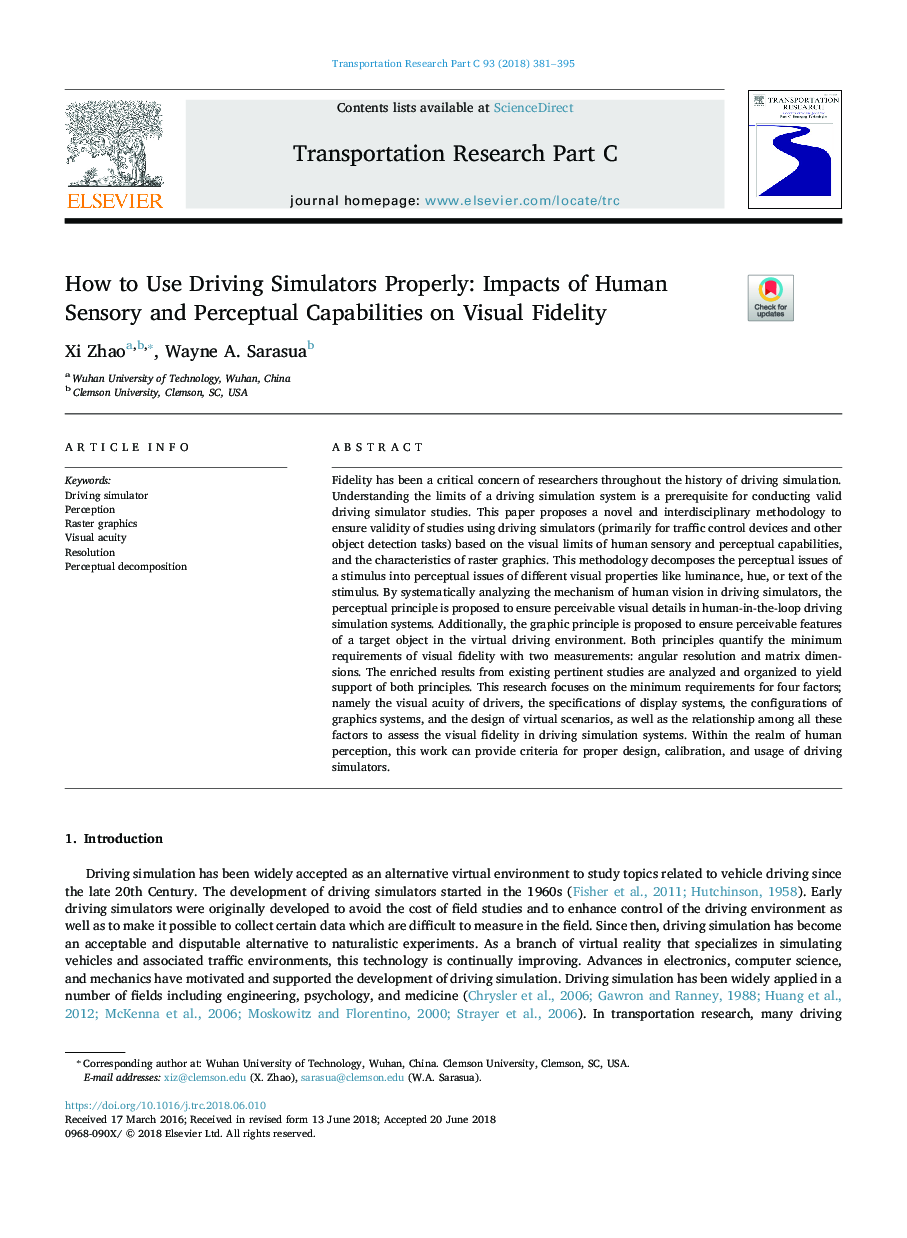| کد مقاله | کد نشریه | سال انتشار | مقاله انگلیسی | نسخه تمام متن |
|---|---|---|---|---|
| 6935775 | 1449655 | 2018 | 15 صفحه PDF | دانلود رایگان |
عنوان انگلیسی مقاله ISI
How to Use Driving Simulators Properly: Impacts of Human Sensory and Perceptual Capabilities on Visual Fidelity
ترجمه فارسی عنوان
نحوه استفاده از شبیه سازهای رانندگی مناسب: اثرات توانایی های ذهنی و ادراکی انسانی بر روی وفاداری بصری
دانلود مقاله + سفارش ترجمه
دانلود مقاله ISI انگلیسی
رایگان برای ایرانیان
کلمات کلیدی
شبیه ساز رانندگی، ادراک، گرافیک ردیف، گشت و گذار در چشم، وضوح، تجزیه ادراکی،
ترجمه چکیده
محرمانه در طول تاریخ شبیه سازی رانندگی نگرانی حیاتی محققان بوده است. درک محدودیت های یک سیستم شبیه سازی رانندگی یک پیش شرط برای انجام مطالعات شبیه ساز رانندگی معتبر است. این مقاله یک روش جدید و بین رشته ای برای اطمینان از صحت مطالعات با استفاده از شبیه سازهای رانندگی (در درجه اول برای دستگاه های کنترل ترافیک و دیگر وظایف تشخیص شیء) بر اساس محدودیت های بصری قابلیت های حسی و ادراکی انسان و ویژگی های گرافیک رادور ارائه می دهد. این روش، مسائل ادراکی محرک را به مسائل ادراکی از ویژگی های بصری مختلف مانند روشنایی، رنگ یا متن محرک تجزیه می کند. با به طور سیستماتیک تجزیه و تحلیل مکانیزم دید انسان در رانندگی شبیه سازها، اصل ادراک پیشنهاد شده است تا جزئیات بصری قابل درک در سیستم های شبیه سازی راننده انسان را در نظر بگیرد. علاوه بر این، اصل گرافیکی برای اطمینان از ویژگی های قابل درک از یک هدف هدف در محیط رانندگی مجازی پیشنهاد شده است. هر دو اصل کمترین الزامات وفاداری بصری را با دو اندازه گیری: ابعاد زاویه ای و ابعاد ماتریس کم می کند. نتایج غنی شده از مطالعات مربوطه در حال حاضر مورد تجزیه و تحلیل قرار گرفته و سازماندهی شده اند تا از هر دو اصل حمایت کنند. این تحقیق بر روی حداقل نیاز به چهار عامل تمرکز دارد. یعنی بینایی بینایی رانندگان، مشخصات سیستم های نمایش، تنظیمات سیستم های گرافیکی و طراحی سناریوهای مجازی، و همچنین ارتباط بین همه این عوامل برای ارزیابی قابلیت اطمینان بصری در سیستم های شبیه سازی رانندگی. در حوزه ادراک انسان، این کار می تواند معیارهای مناسب طراحی، کالیبراسیون و استفاده از شبیه ساز های رانندگی را فراهم کند.
موضوعات مرتبط
مهندسی و علوم پایه
مهندسی کامپیوتر
نرم افزارهای علوم کامپیوتر
چکیده انگلیسی
Fidelity has been a critical concern of researchers throughout the history of driving simulation. Understanding the limits of a driving simulation system is a prerequisite for conducting valid driving simulator studies. This paper proposes a novel and interdisciplinary methodology to ensure validity of studies using driving simulators (primarily for traffic control devices and other object detection tasks) based on the visual limits of human sensory and perceptual capabilities, and the characteristics of raster graphics. This methodology decomposes the perceptual issues of a stimulus into perceptual issues of different visual properties like luminance, hue, or text of the stimulus. By systematically analyzing the mechanism of human vision in driving simulators, the perceptual principle is proposed to ensure perceivable visual details in human-in-the-loop driving simulation systems. Additionally, the graphic principle is proposed to ensure perceivable features of a target object in the virtual driving environment. Both principles quantify the minimum requirements of visual fidelity with two measurements: angular resolution and matrix dimensions. The enriched results from existing pertinent studies are analyzed and organized to yield support of both principles. This research focuses on the minimum requirements for four factors; namely the visual acuity of drivers, the specifications of display systems, the configurations of graphics systems, and the design of virtual scenarios, as well as the relationship among all these factors to assess the visual fidelity in driving simulation systems. Within the realm of human perception, this work can provide criteria for proper design, calibration, and usage of driving simulators.
ناشر
Database: Elsevier - ScienceDirect (ساینس دایرکت)
Journal: Transportation Research Part C: Emerging Technologies - Volume 93, August 2018, Pages 381-395
Journal: Transportation Research Part C: Emerging Technologies - Volume 93, August 2018, Pages 381-395
نویسندگان
Xi Zhao, Wayne A. Sarasua,
